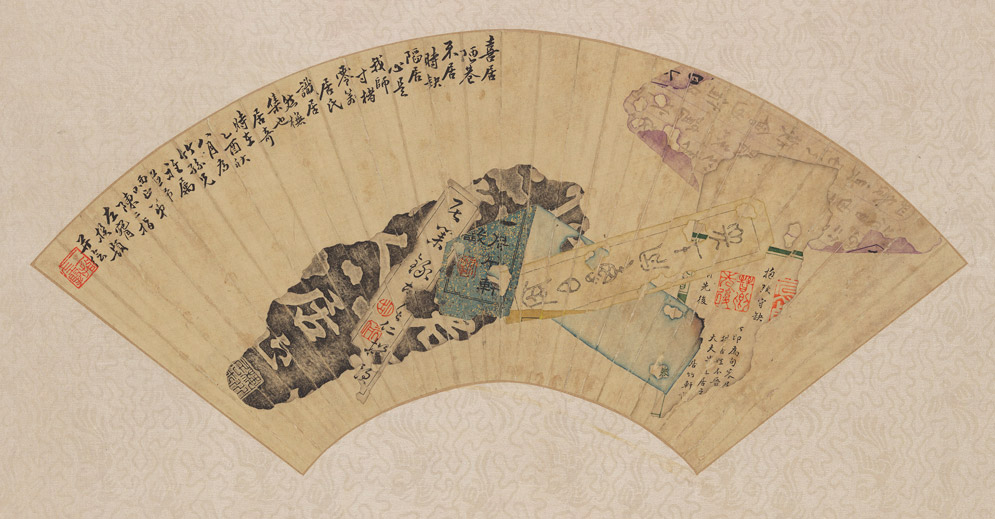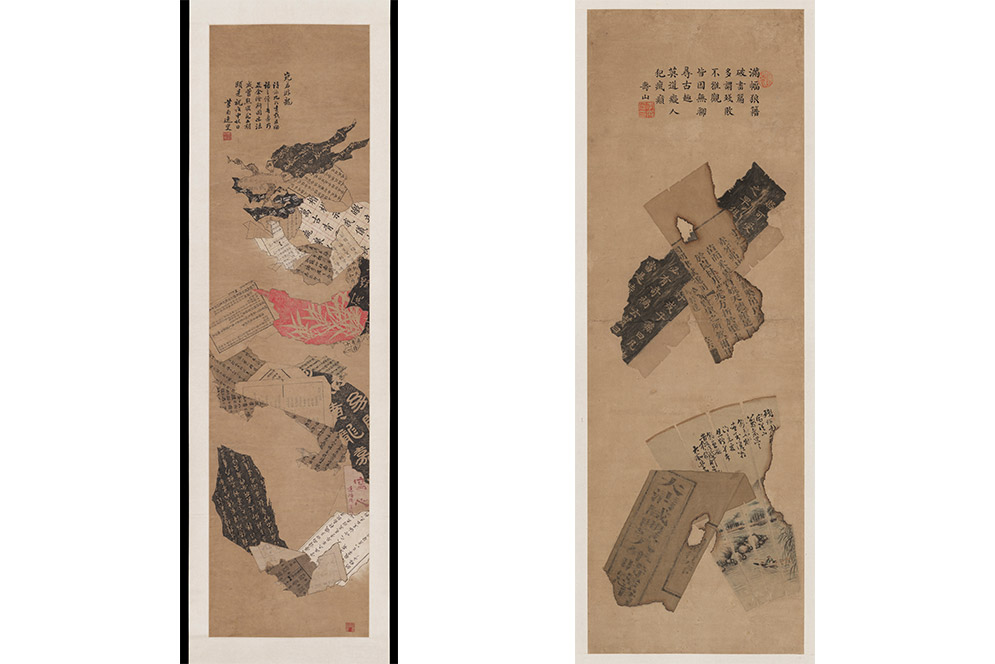Deciphering Bapo Painting
MFA Presents China’s 8 Brokens: Puzzles of the Treasured Past

Untitled, 1900, Unidentified Artist. Ink and color on paper. Photograph © Museum of Fine Arts, Boston
For most people, 19th-century Chinese painting conjures up images of tranquil landscapes and figures, but a groundbreaking new exhibition at the Museum of Fine Arts shines a light on a very different and largely forgotten genre known as bapo painting. Similar to collages, these works, most from the mid 19th century, feature reproduced fragments of cultural treasures in seemingly haphazard arrangements that often hold hidden meanings.
China’s 8 Brokens: Puzzles of the Treasured Past is a revelation. Thoughtfully put together by Nancy Berliner, the MFA’s curator of Chinese art, it is on view through October 29. The genre is known by a variety of names, “bapo,” “damaged pages,” and “eight brokens,” the last now the universally accepted one. The number eight is an auspicious number in Chinese culture, symbolizing good luck, and broken or incomplete objects are preferred to perfect ones, because perfection can invite misfortune.

Willing to Reside in a Shabby Alley (front side), 1945, Chen Bingchang. Ink and color on silk. Photograph © Museum of Fine Arts, Boston
Creating compositions displaying fragments of the country’s cultural treasures dates back to eighth-century China, when artists began pasting cherished snippets of poetry, calligraphy, and paintings onto large screens. It became popular again in the 17th century, and by the 18th century artists were reproducing famous calligraphies and paintings directly onto scrolls, ceramics, and lacquer screens. But bapo painting represented a departure, placing an emphasis on decay: historic remnants were depicted as half burned, torn, even worm-eaten.
Bapo paintings are famous for including hidden meanings that have been tucked within their compositions, hence the reference to “puzzles” in the exhibition title. Part of the fun of the show is seeing how artists arranged and layered scraps of paper to suggest various meanings. For example, in Zhu Wei’s A Complete Picture of 100 Years, 1903, one of a set of six panels, the broken bits have been assembled in the shape of a dragon. Why? Could the work be an act of protest against the Taiping Rebellion—which the artist lived through—when many libraries were burned and treasures destroyed? Are Zhu Wei’s depictions of tattered calligraphies and books a kind of political commentary, or as the artist noted in an inscription, is the work simply meant to reflect wishes for longevity?

A Complete Picture of 100 Years, 1903, by Zhu Wei. Ink and color on paper (left). Burned, Ruined, Damaged Fragments; one of four, 1938, by Li Chengren, ink and color on paper (right). Photographs © Museum of Fine Arts, Boston
Many of the works here are an homage to calligraphy, which was considered the most sophisticated of all artistic endeavors. In another set of panels by Zhu Wei, also titled A Complete Picture of 100 Years, traditional calligraphy and rubbings appear alongside other calligraphic objects, including decorated stationery, calligraphy practice sheets, printed books, and envelopes with handwritten addresses, a testament to the esteem the art form was held in.
Serious art critics at the time were dismissive of bapo, or broken-eights, painting, both because of its emphasis on reproduction and its realism. The public had no such qualms: it was hugely popular among the middle class, who saw in it a reflection of their own values. Nonetheless, by the middle of the 20th century, the genre was essentially abandoned. As the exhibition notes, bapo has never been included in any official history of Chinese art. China’s 8 Brokens: Puzzles of the Treasured Past could be a first step in rectifying that.
China’s 8 Brokens: Puzzles of the Treasured Past is on view at the Museum of Fine Arts, 465 Huntington Ave., Boston, through October 29. Find hours and admission prices here (free to BU students with ID). Find directions here.
Comments & Discussion
Boston University moderates comments to facilitate an informed, substantive, civil conversation. Abusive, profane, self-promotional, misleading, incoherent or off-topic comments will be rejected. Moderators are staffed during regular business hours (EST) and can only accept comments written in English. Statistics or facts must include a citation or a link to the citation.